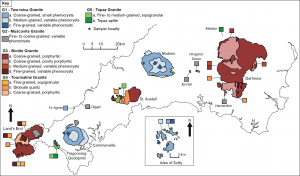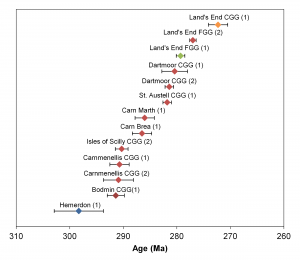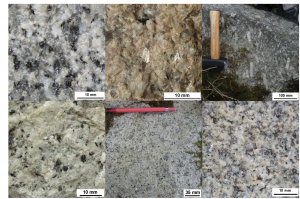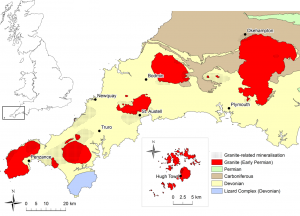
The Cornubian Batholith is the large mass of granite that forms much of the peninsula of SW England. It is exposed in a series of six major plutons (large igneous bodies exposed as irregular outcrops) and several minor stocks, intruded into Devonian and Carboniferous aged metasedimentary and igenous rocks. Gravity survey data indicate that the granite is continuous at depth (i.e. all the plutons are joined below the surface) and as a whole it is over 250 km long, 20-40 km wide and up to 10 km thick. There’s also an extra little pluton, the Haig Fras Batholith, to the northwest, hidden beneath the ocean. So that’s a whole lot of granite!
The batholith owes its origin to the Variscan Orogeny, a mountain building event that occurred in the late Palaeozoic. You can read more about the Variscan here.
But isn’t granite all just granite? Errrrr…no. Granites are super fascinating, and show considerable variation in their textures, mineralogy and chemistry – even down to the metre scale. They vary so much you could spend a lifetime trying to figure out even a single location, let alone what is going on in an entire batholith.
Perhaps rather ambitious, but my PhD looked at the regional variations within the Cornubian Batholith and what that meant for the behaviour of low carbon technology metals across the region (e.g. the lithium in your electric car and the indium in your touch screen). All the conclusions are based on the current exposure level of the batholith, alongside observations made from the Rosemanowes and Bosworgy boreholes drilled within the granite. We are literally only scratching the surface of the batholith, and can only hazard a guess at what is happening at depth.
You can find the complete PhD here, but the sections below very briefly summarise the main findings. You can also read the papers here (£) and here (open access) for more information.
There’s not a lot about the regional tectonic evolution, lamprophyres and basalts or mineralisation in this section. They’re stories that deserve their own pages: Tectonics, Lamprophyres, Timeline, Mineralisation. There’s also a separate page about elvans and rhyolites, which are associated with the batholith, but would make this page far too long! Have also left out what is happening to the rare metals – get in touch if you want this information.
Why does this even matter?
You might ask – why do we need to know all this about the granite in SW England? The Cornubian Batholith, and the fluids derived from it, are responsible for a large proportion of the mineralisation in southwest England. Our mining heritage is an important part of our history, and discoveries and inventions in Cornwall and Devon have been, and still are, used the world over. Understanding the granites also helps to understand the tectonic evolution of this part of the world and understand why our landscape is the way it is today.
References
- Chappell BW, Hine R. 2006. The Cornubian Batholith: an example of magmatic fractionation on a crustal scale. Resource Geology 56, 203-244. [PDF – £]
- Chesley JT, Halliday AN, Snee LW, Mezger K, Shepherd TJ, Scrivener RC, 1993. Thermochronology of the Cornubian Batholith in southwest England: Implications for pluton emplacement and protracted hydrothermal mineralisation. Geochimica et Cosmochimica Acta 57, pp. 1817-1835. [PDF – £]
- Cuney M, Barbey P. 2014. Uranium, rare metals and granulite-facies metamorphism. Geoscience Frontiers, 1-17. [PDF]
- Dangerfield, J., Hawkes, J.R., 1981. The Variscan granites of south-west England: additional information. Proceedings of the Ussher Society 5, 116-120. [PDF]
- Exley, C.S., Stone, M., 1964. The granitic rocks of south-west England, in: Hosking, K.F.G., Shrimpton, G.J. (Eds.), Present views of some aspects of the geology of Cornwall and Devon. Royal Geological Society of Cornwall, Penzance, pp. 131-184.
- Ghosh PK. 1934. The Carnmenellis Granite: Its petrology, metamorphism and tectonics. Quarterly Journal of the Geological Society, 90, 240-276. [PDF – £]
- Henderson CMB, Martin JS, 1989. Compositional relations in Li-micas from SW England and France: an ion- and electron-microprobe study. Mineralogical Magazine 53, 427-449. [PDF – £]
- Kratinová Z, Ježek J, Schulmann K, Hrouda F, Shail RK, Lexa O. 2010. Noncoaxial K-feldspar and AMS subfabrics in the Land’s End granite, Cornwall: Evidence of magmatic fabric decoupling during late deformation and matrix crystallization. Journal of Geophysical Research: Solid Earth 115, 1-21. [PDF – £]
- Manning DAC, Hill PI, Howe JH. 1996. Primary lithological variation in the kaolinized St. Austell Granite, Cornwall, England. Journal of the Geological Society 153, 827-838. [PDF – £]
- Müller A, Seltmann R, Halls C, Siebel W, Dulski P, Jeffries T, Spratt J, Kronz A. 2006. The magmatic evolution of the Land’s End pluton, Cornwall, and associated pre-enrichment of metals. Ore Geology Reviews 28, 329-367. [PDF – £]
- Stimac JA, Clark AH, Chen Y, Garcia S. 1995. Enclaves and their bearing on the origin of the Cornubian Batholith, southwest England. Mineralogical Magazine 59, 273-296. [PDF – £]
- Stone, M., 1992. The Tregonning Granite: petrogenesis of Li-mica granites in the Cornubian Batholith. Mineralogical Magazine 56, 141-155. [PDF – £]
